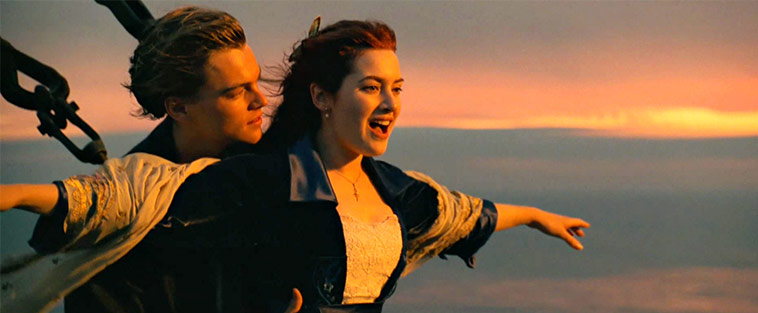
By John Schauer
Sometimes the power of a film can sneak up on you and catch you by surprise. That was the experience I had when I saw James Cameron’s film Titanic—for the third time.
My first exposure to Titanic was different than it was for most people. A friend of mine who worked for a newspaper had passes to see a press preview of the film before it was released in 1997. There had been a lot of speculation that the film would be a flop, because its original release date had been postponed, a situation that usually gets the film crowd talking. But I hadn’t been aware of any of that. All I knew was that it was a free ticket to see a film about the sinking of the Titanic, a subject that had long interested me and which I had seen portrayed in several previous films. I still have a soft spot in my heart for the surprisingly affecting 1953 version starring Barbara Stanwyck and Clifton Webb.

I was highly impressed by Cameron’s film, but not for the reasons that made it a box office sensation, particularly with young female viewers. I didn’t really care at all about the love story; I knew Leonardo DiCaprio to be a fine young actor, but thought his character was two-dimensional, and I frankly didn’t like Kate Winslet at all, so their rocky road to romance didn’t particularly resonate with me. Rather, I was blown away by the special effects. It really gave me the feeling I had actually witnessed that fateful night; the next day when I awoke, I was still disturbed to think of all those poor people who perished in the icy waters.
So on the basis of those dazzling effects, I recommended the film to friends and went along when they went to see it after it was released. My reaction was pretty much the same the second time: eye-popping special effects that made the ship seem real, against which was set what seemed to me to be a contrived love story.
Fast-forward to 2012, when the film was re-released in 3D for the centennial of the actual ship’s sinking. (That release, by the way, pushed Titanic’s box office earnings over $2 billion, making it the second film to earn that much; the first film that had done so was another James Cameron film, Avatar, released in 2009, before which Titanic had achieved the status of the highest grossing film of all time.) I went with a group of coworkers, but my only interest was how effective post-production 3D would be in a movie not originally filmed in that process. For the record, I found the 3D to be nothing short of amazing; it made me hope that many other classic films would be given the same treatment. But that isn’t what took me off guard.
When the final credits had finished and the house lights came up, my colleagues started casually discussing the 3D; I don’t know if any of them were seeing it for the first time. But I couldn’t take part in the discussion: I was sitting in my theater seat, sobbing convulsively, unable to speak, my body shaking, the tears streaming like Niagara Falls. For some reason I don’t understand, this time I was devastated by Rose’s tragic loss of her beloved Jack. I mean like for real, as if I personally had lost a loved one. It took me quite a while to recover my emotional composure.
I never figured out why. Lord knows, I knew everything that was going to transpire in the film: the world’s largest ocean liner would sink, over a thousand people would die, and Rose would live the rest of her life memorializing her lost love. I think it’s the scene where Rose finally dies and sees her beloved Jack on the revitalized Titanic that pushed me over the edge, but again, I had viewed that scene twice before and had stayed dry-eyed.

I later read an article claiming that many audience members who attended the 2012 re-release were reacting similarly across the country, most of them women who had first viewed the film’s initial release as young ’tweens or teens and were seeing it again for the first time as an adult. That was certainly not my case, and I don’t think my own life situation had changed much between my first and last viewings.
But, ultimately, explanations don’t really matter. As Janis Joplin once sang, something grabbed ahold of me, and it felt like a ball and chain, dragging me down with the ship. With the Chicago Symphony Orchestra performing the Academy Award–winning score live, no doubt several thousand people attending the Ravinia screenings on July 29 and 30 will find themselves similarly swept away.
Tickets for the July 29 screening can be purchased here while tickets for the July 30 screening can be purchased here.
